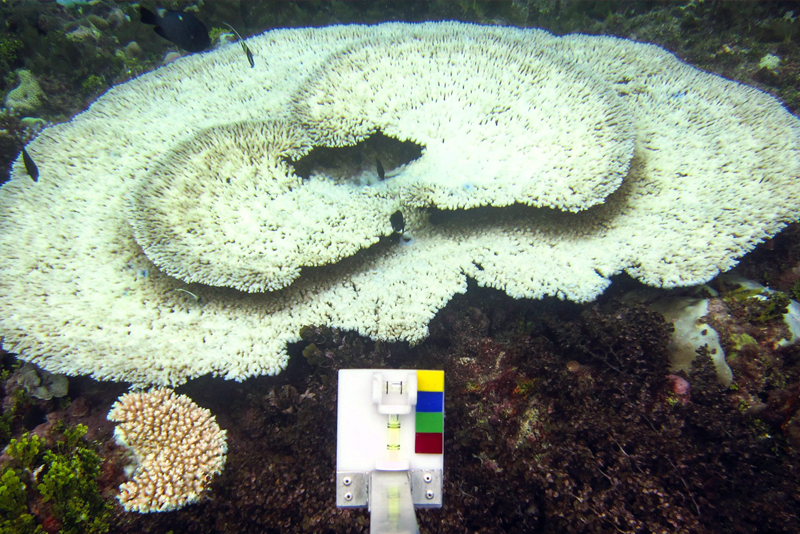Philippine reef status calls for urgent attention

Photo shows a bleached colony of Acropora recorded during surveys in Mancagangi marine protected area in Surigao del Sur. Photo by Arah Narida
MANILA, Philippines — The Great Barrier Reef’s condition is worsening, while Philippine coral reefs are bound to the same fate unless something is done.
Over recent decades, divers and scientists have witnessed firsthand the alarming damage to reefs vital to the health of Philippine seas.
Last year, a team of divers and marine biologists recorded the occurrence of coral bleaching on the reefs at 19 marine protected areas (MPAs) in Lanuza Bay, Surigao del Sur.
“Corals were bleaching between depths of three to 30 meters, left and right,” Haribon Foundation said.
The National Ocean and Atmospheric Administration (NOAA) of the US government raised the bleaching status in Eastern Philippines to Alert Level 2, the highest alert level, in July 2017.
There are many reasons why corals bleach. It takes place when water temperatures rise, during extreme low tide, high solar light and due to run-off from pollution.
When bleaching happens, corals lose their zooxanthellae, the algae that lives inside them in symbiosis or mutually beneficial relationship. Zooxanthellae provide corals 80 percent of their food and give them color. Without the algae, corals turn white or very pale.
Different species were losing their zooxanthellae as the temperature rose to 30?C in Lanuza Bay.
Once corals turn white, they become susceptible to disease. They also lose their ecosystem functions including carbon sequestration, sheltering fish and other marine life, and protection from strong waves.
But while they appear like “graveyards” for a time, corals can actually recover as long as the water cools down, pollutants are removed, and overfishing and other threats are stopped.
Year of the Reef
The International Coral Reef Initiative declared 2018 as the third International Year of the Reef (IYOR), a global effort to help raise awareness and urge conservation action on the world’s reefs.
The first IYOR was marked in 1997 in response to the increasing threats and loss of coral reefs, primarily for the largest bleaching event that occurred in recent history. The second IYOR happened in 2008, bringing to attention the value of reefs as a source of livelihood and calamity protection.
This year’s IYOR also seeks to promote partnerships among governments, the private sector, academe and civil society on the management of coral reefs.
The marine protected areas in Lanuza Bay are managed by community-based organizations and local governments. The monitoring of the MPAs and the reporting of coral bleaching events will help managers develop ways to prevent poaching, pollution and other threats from entering the MPAs.
This is in coordination with several initiatives where Haribon is involved including the Marine Protected Area Support Network (MSN) and the Philippine Coral Bleaching Watch, an online reporting for bleaching utilizing citizen science.
Through the Strengthening the Marine Protected Areas to Conserve Marine Key Biodiversity Areas in the Philippines Project, or SMARTSeas, Haribon supports the marine protected area management in Lanuza Bay.
The project is implemented by the Department of Environment and Natural Resources and is funded by the Global Environment Facility with support from the United Nations Development Program.
- Latest






























